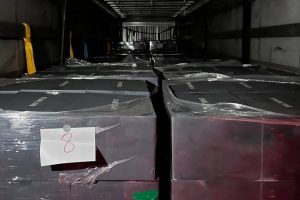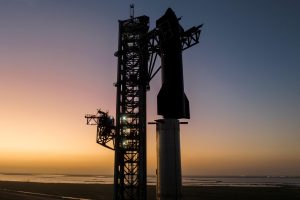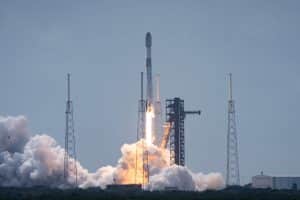SpaceX has shipped, tested, and delivered the new Falcon 9 upper stage tasked with carrying the company’s next Crew Dragon astronauts to orbit as early as October 30th.
Offering rare insight into the kind of timelines and margins SpaceX operates on for even its most important missions, a Falcon upper stage bearing NASA’s ‘worm’ logo and ‘meatball’ insignia was spotted by a local resident and photographer on October 2nd. Thus far, the only SpaceX rockets that have flown with NASA iconography are those supporting Crew Dragon launches, making them a dead giveaway for Crew Dragon launch hardware.
After Demo-2, SpaceX’s May 2020 astronaut launch debut, the company moved those decals from Falcon 9’s booster – liable to fly any number of non-NASA missions later in life – to each NASA crew mission’s expendable Falcon second stage (S2). Since then, Crew-1 (November 2020) and Crew-2 (April 2021) have both launched with NASA logos on their second stages and Crew-3 now looks set to continue that tradition.
Thanks to the watchful eye of local resident turned SpaceX fan Reagan Beck, it was actually possible to identify Crew-3’s Falcon 9 upper stage as soon as it was spotted at the company’s McGregor, TX development and testing facilities on October 2nd. While there was technically a tiny chance that it could be for one of several upcoming NASA spacecraft launches or even for Crew Dragon’s April 2022 Crew-4 mission, the likeliest destination by far for the NASA-branded Falcon S2 was Crew-3.
Due partially to the fact that Falcon booster qualification testing typically takes McGregor at least two or so weeks but mainly to the seemingly razor-thin schedule margins it would imply, there was some understandable skepticism that the upper stage was bound to launch Crew-3 just four weeks after it was first spotted. Moreso, Crew Dragon typically rolls out to the launch pad on Falcon 9 at least 5-7 days before launch to allow extra time for an integrated static fire, final checkouts, and a ‘dry dress’ practice runs for each mission’s crew.
Further, even after completing static fire qualification testing in McGregor, Crew-3’s Falcon stage would still need to be packaged up, transported more than a thousand miles by road, carefully unpackaged at a SpaceX launch site or hangar, outfitted with a Merlin Vacuum nozzle extension, installed on the mission’s Falcon 9 booster, and mated to Crew Dragon itself before that pad rollout can occur. In other words, rather than Crew-3’s exact October 30th launch date, the mission’s upper stage would likely need to arrive at SpaceX’s Kennedy Space Center (KSC) Pad 39A launch facilities at least 9-10 days before launch.
Realistically, that means that from the moment the NASA-branded upper stage first spotted on a McGregor test stand, it had maybe two weeks to complete qualification testing and ship out to Pad 39A. With practically no context, that seemed like a stretch at the time – particularly for a single-engine Falcon second stage explicitly tasked with safely delivering four astronauts to orbit. In reality, McGregor’s Falcon S2 testing is apparently far faster than booster testing and the presumed Crew-3 stage seemingly passed qualification testing and vacated the test stand less than five days after it was installed.
In theory, that left the McGregor team about a week to complete post-test inspections, clean the interior of its propellant tanks, and prepare the stage for the last leg of its journey to Florida. SpaceX seemingly managed that without issue and a new Falcon upper stage – potentially for Crew-3 was spotted on Florida just a few miles away from a SpaceX launch site on October 14th.
However, per additional photos and reports from Reagan, McGregor’s second stage test team has been incredibly busy over the last month or so. Prior to the Crew-3 stage’s arrival, another second stage completed qualification testing between September 21st and 28th. Crew-3’s S2 was installed on October 2nd and removed by the 7th. Wasting no time, another second stage was installed on the same stand on October 10th and apparently completed testing by the 13th – equivalent to a new upper stage qualified every week. Even if the Falcon stage that arrived at Cape Canaveral on October 14th isn’t Crew-3’s, then, Crew-3’s can’t be far behind.

Ultimately, SpaceX appears to be testing and shipping one of two integral Falcon 9 stages for a crucial, schedule-sensitive NASA astronaut launch with schedule margins measured in hours or single-digit days. That’s a far cry from competitors Arianespace and ULA and even NASA itself, which generally deliver flight hardware months in advance. Eleven years since Falcon 9’s launch debut, every Falcon second stage that has made it through stage separation – 127 of 127 – has successfully ignited its Merlin Vacuum engine one or several times and delivered its payload(s) to the correct orbit(s). Well over half of those successful launches were completed in the last three and a half years – and with the same Falcon 9 upper stage variant now routinely tasked with carrying astronauts to orbit.
In other words, delivering a NASA Crew mission’s Falcon second stage less than two weeks before the assembled rocket is scheduled to roll out to the launch pad may seem a tad reckless, it’s more likely that it’s evidence of SpaceX’s second stage build/test teams and facilities operating as an incredibly reliable, well-oiled machine.





